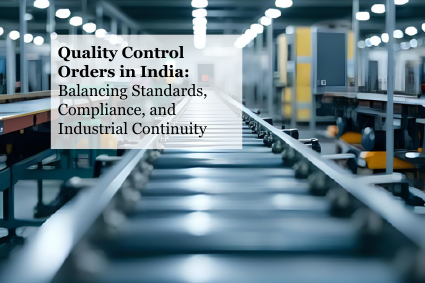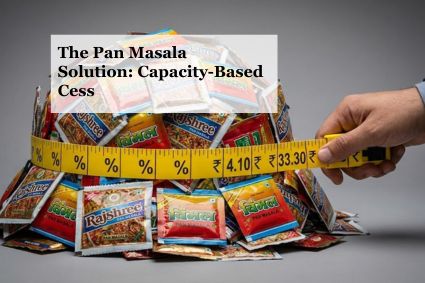Quality Control Orders in India: Balancing Standards, Compliance, and Industrial Continuity

Introduction
India’s quality regulation framework has undergone a significant transformation in recent years. The government’s increasing reliance on Quality Control Orders (QCOs) under the Bureau of Indian Standards (BIS) Act reflects a determined policy shift toward strengthening product reliability, consumer safety, and the credibility of Indian manufacturing in global markets.
While this shift is ambitious and forward-looking, it has also presented operational challenges. The rapid expansion of mandatory standards has increased compliance obligations and affected supply chains. For general counsel, compliance heads, and business leaders, the QCO regime now represents a complex intersection of regulatory compliance, trade policy, and industrial strategy.
The Evolution of QCOs: A Policy Tool Reinvented
Historically, Indian standards were largely voluntary, focusing on limited product categories such as electrical goods and safety equipment. Over the past five years, however, the scope of QCOs has expanded across multiple sectors, including chemicals, steel, automotive components, electronics, and textiles.
Under the BIS Act, 2016, the government is empowered to issue QCOs mandating that certain products, whether domestically produced or imported, conform to Indian Standards before sale or use in India. The objectives are clear: enhancing consumer protection, promoting domestic manufacturing excellence, and curbing the influx of substandard imports.
This regulatory expansion signals India’s transition toward a standards-led economy. By aligning Indian products with international benchmarks, QCOs also enhance global credibility and help position India as a trusted source of quality-compliant goods.
Strengthening Manufacturing and Trade Leverage
The benefits of QCOs extend beyond consumer protection; they are emerging as a strategic instrument in both industrial development and trade diplomacy.
A notable example is the fisheries sector. The European Union, which had blocked Indian fisheries exports for nearly nine years, reopened its market for 102 new Indian establishments after India strengthened its quality and certification regime. Similarly, Russia is considering approvals for 25 Indian entities to export seafood, enabling diversification beyond the US market, where high tariffs have constrained exports.
Globally, quality standards are used as both defensive and diplomatic tools. By mandating QCOs, India has gained leverage in trade discussions, secured improved market access, and reinforced its reputation as a credible supplier of compliant goods. These developments align closely with the Atmanirbhar Bharat and Make in India initiatives, which aim to deepen self-reliance and enhance export competitiveness.
The Toy Industry Case Study: Quality as a Growth Driver
The toy industry exemplifies how QCOs can stimulate domestic capability and export potential.
The Government of India has taken comprehensive measures to create a conducive manufacturing ecosystem for the toy sector. These initiatives promote “Made in India” toys, encourage designs inspired by Indian values and culture, and leverage toys as educational tools. Through quality monitoring, restrictions on sub-standard imports, and support for indigenous clusters, the sector has seen remarkable growth. Between FY 2014–15 and FY 2022–23, toy imports declined by 52%, while exports surged by 239%, reflecting the success of sustained policy interventions.
To reinforce these gains, the Directorate General of Foreign Trade (DGFT) mandated sample testing for every imported consignment to ensure only quality-compliant toys enter the market. Consignments failing to meet prescribed standards are either returned or destroyed at the importer’s cost.
Additionally, the government increased the Basic Customs Duty (BCD) on toys under HS Code 9503 from 20% to 60% in February 2020 and to 70% in March 2023, discouraging non-compliant imports and supporting domestic manufacturers.
The introduction of the Toys (Quality Control) Order, 2020, made BIS certification mandatory for all toys, both domestically produced and imported, from January 2021. This ensured compliance with Indian safety standards, improving consumer confidence and the global reputation.
To support small-scale artisans, the QCO was amended in December 2020 to exempt products made and sold by registered artisans and authorized users of Geographical Indication (GI) goods, recognizing traditional craftsmanship and heritage toy-making clusters.
Further, BIS relaxed norms for micro-scale toy manufacturers by allowing licenses without mandatory in-house testing facilities. As of January 2024, 1,454 licenses have been granted to domestic manufacturers and 36 to foreign producers under standards IS 9873 and IS 15644.
The National Action Plan for Toys (2020), involving 14 Central Ministries, added further momentum. Covering 21 action points across themes such as trade promotion, domestic design, and the educational use of toys, the plan seeks to position India as a global hub for toy production.
Recent Free Trade Agreements (FTAs), such as the India–UAE CEPA and the India–Australia ECTA, now provide zero-duty market access for Indian toy exports, which is expected further to strengthen India’s position in global toy markets.
Compliance Costs and Capacity Constraints
Despite these gains, implementation challenges remain. Each QCO involves testing, certification, documentation, and periodic audits. Compliance depends not just on corporate diligence but also on the availability of accredited testing infrastructure.
For large corporations, the additional cost translates into extended compliance cycles and higher budgets. For micro, small, and medium enterprises (MSMEs), certification fees ranging from ₹10,000 to ₹50,000 per product variant can be significant. Limited BIS-approved testing facilities also create bottlenecks, delaying product launches and increasing inventory costs.
However, policy adaptations are underway. BIS has relaxed norms for micro and small enterprises, permitting simplified licensing and extended validity. These initiatives aim to ensure that the pursuit of quality does not become exclusionary.
Supply Chain and Global Integration
The extension of QCOs to input materials and intermediate goods has reshaped industrial supply chains. While initially disruptive, this move encourages domestic sourcing, higher value addition, and long-term resilience.
In sectors such as steel, chemicals, and electronics, QCOs have driven the establishment of local testing ecosystems, reduced reliance on imported substandard components, and enhanced the quality baseline across manufacturing networks. For export-oriented industries, dual compliance with Indian and international standards presents challenges but also elevates their competitiveness in regulated global markets.
Balancing Policy Intent with Industrial Reality
The QCO framework’s effectiveness depends on reconciling regulatory ambition with operational feasibility. A structured, consultative, and phased approach can help sustain momentum while addressing industrial concerns.
Policy refinements worth consideration include:
• Phased implementation and realistic transition timelines for QCOs covering critical materials.
• Expansion of BIS-accredited labs and participation of private testing agencies.
• Mutual recognition agreements with trusted foreign regulators to prevent redundant testing.
• Mandatory stakeholder consultations before issuing new QCOs.
• Wider use of digital certification systems to enhance efficiency and transparency.
If implemented effectively, these measures can transform QCOs into a cornerstone of industrial transformation rather than a compliance burden.
QCOs as a Catalyst for Industrial Transformation
The broader trend suggests that QCOs are gradually evolving into a catalyst for industrial modernization. By enforcing consistent quality standards, they encourage product innovation, build consumer trust, and align the Indian industry with international expectations.
India’s move toward a standards-based regime supports its aspiration to become a manufacturing hub under the Make in India and Atmanirbhar Bharat initiatives. A predictable and harmonized quality framework enhances investor confidence and positions India as a reliable trade partner.
Reform & Recommendations
The proposed reforms aim to ease regulatory pressure while retaining essential quality standards by rationalising QCOs across key sectors. They include revoking QCOs for major synthetic fibres and yarns, several plastics and polymers, and key base metals, all to be implemented by 15 November 2025. In the steel sector, QCOs for construction, pressure vessels, and pipes will continue, while implementation for engineered, automotive, electrical-grade, alloy steel, and consumer-end products will be suspended for IMG review. The proposal also seeks to revoke the SIMS and NOC requirements for non-BIS steel grades to streamline imports. Further, QCOs on selected footwear and electronics components will be withdrawn, and all upcoming QCOs/OTRs on raw materials, intermediates, and capital goods will be deferred and reviewed to ensure balanced, industry-friendly regulation.
Conclusion
Quality Control Orders embody India’s ambition to institutionalize quality and reliability across industries. The long-term success of this framework depends on maintaining a careful balance that promotes quality and competitiveness without overburdening compliance systems.
As India integrates further into global value chains, QCOs, if implemented with foresight, flexibility, and collaboration, can serve as a foundation for sustained growth. The goal is not regulation for its own sake, but a standards ecosystem that empowers innovation, supports businesses, and strengthens India’s global manufacturing identity.
By entering the email address you agree to our Privacy Policy.



